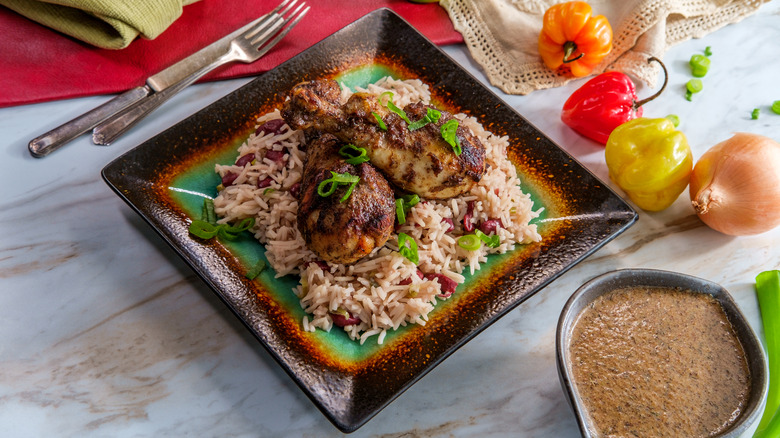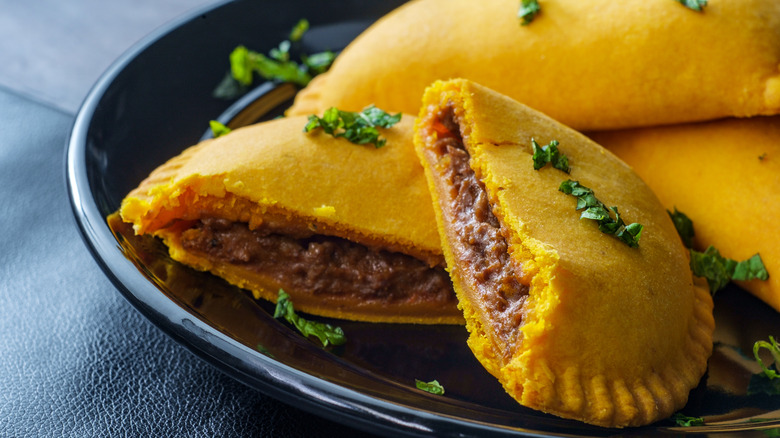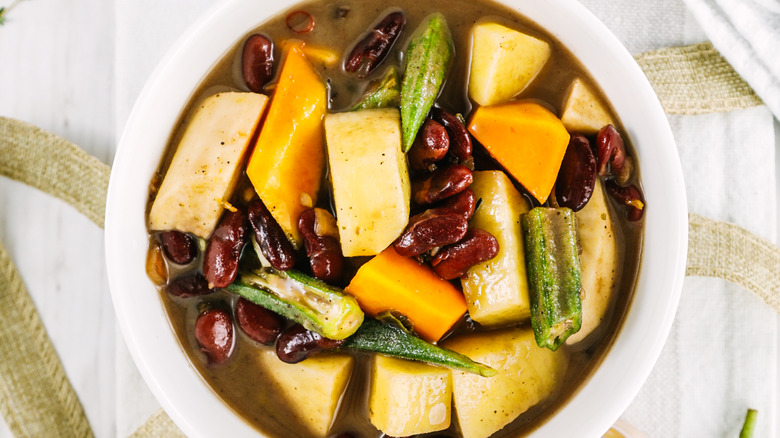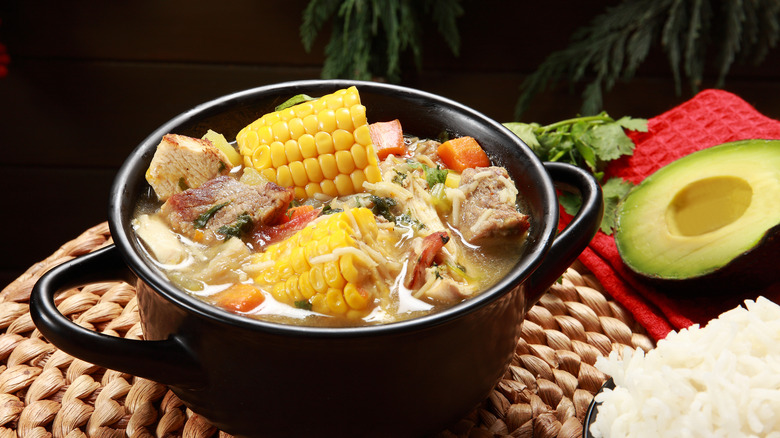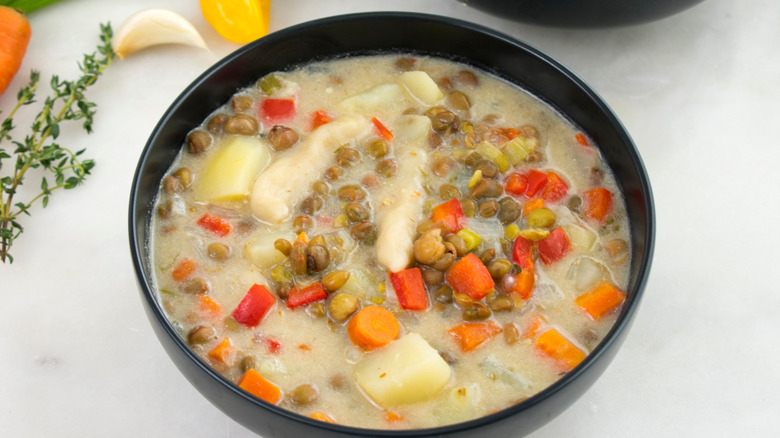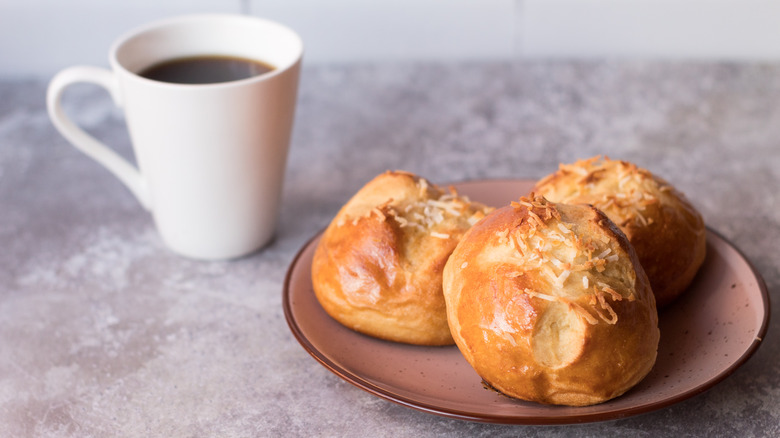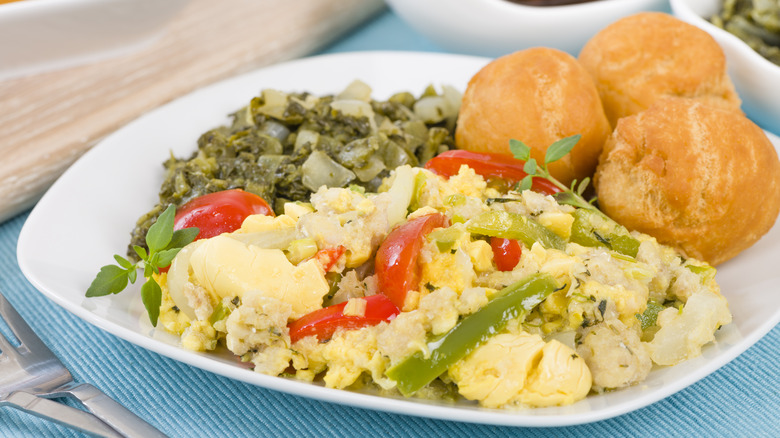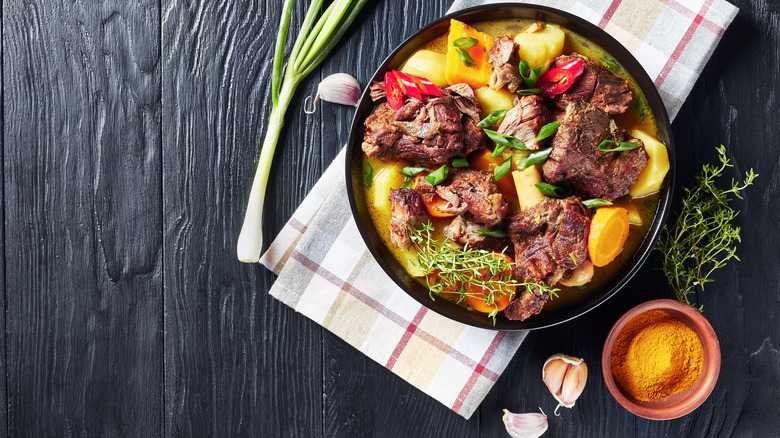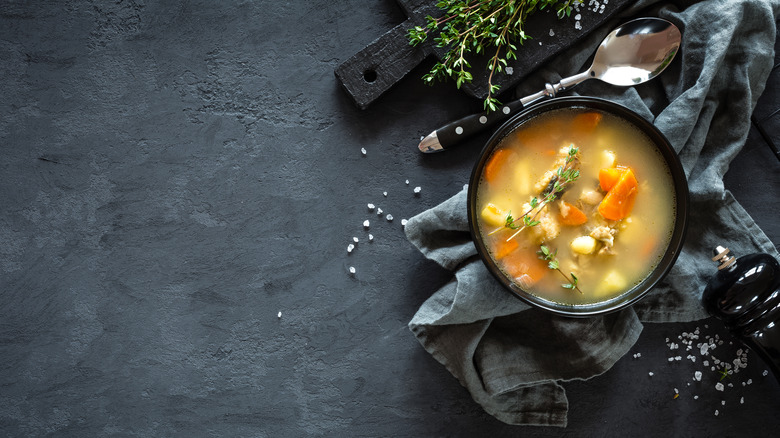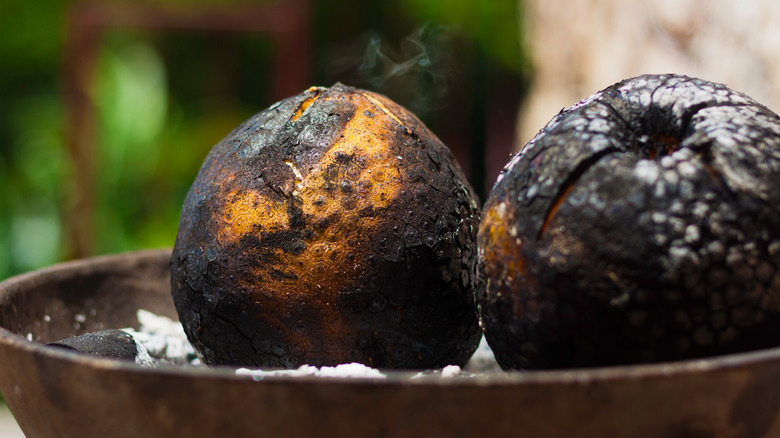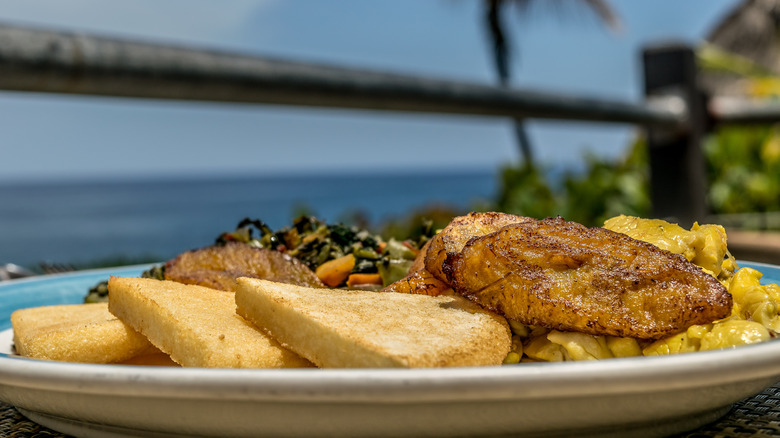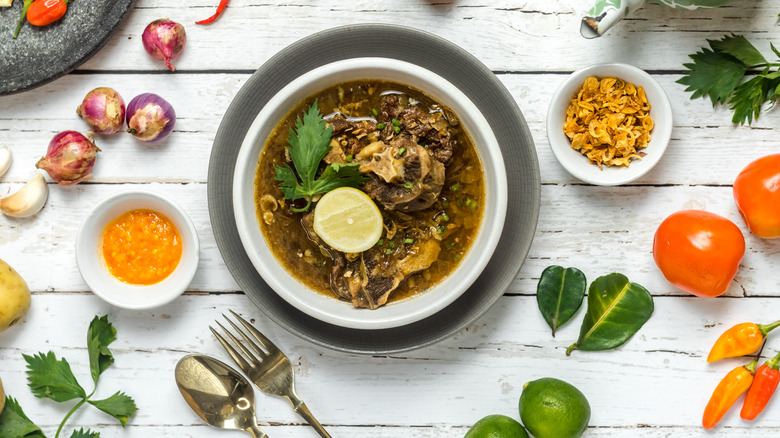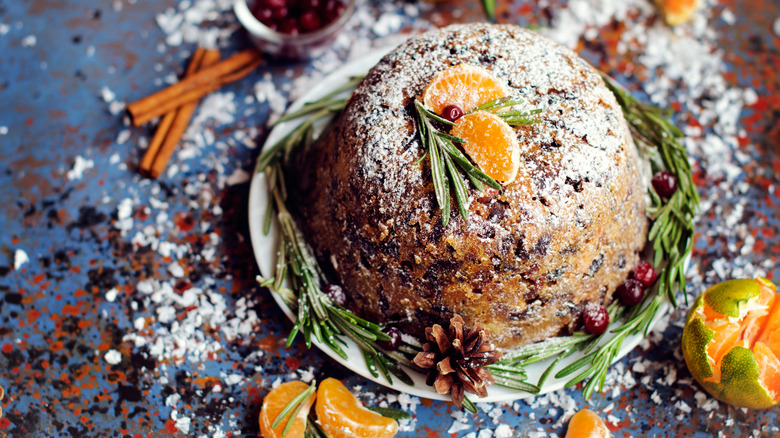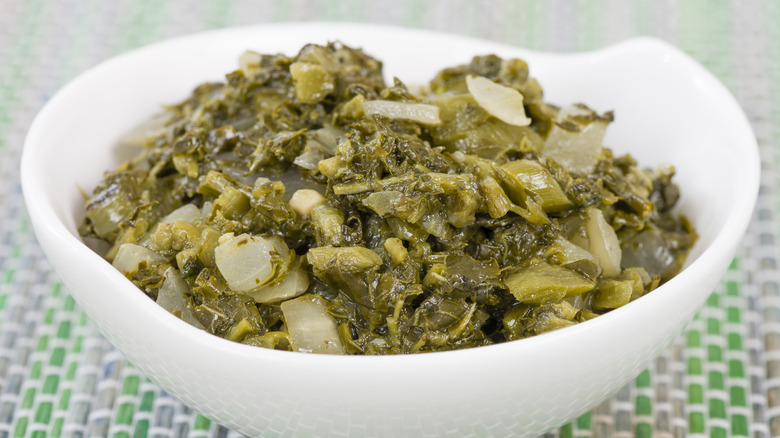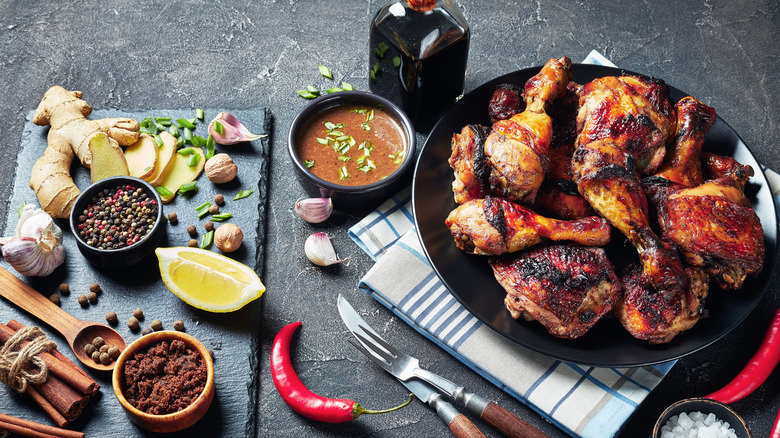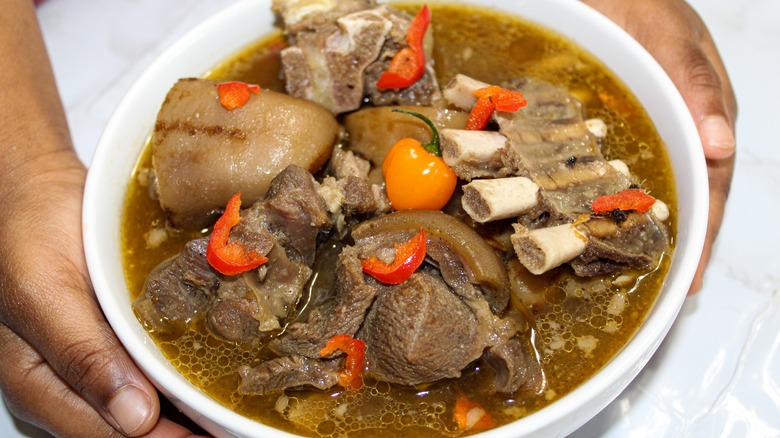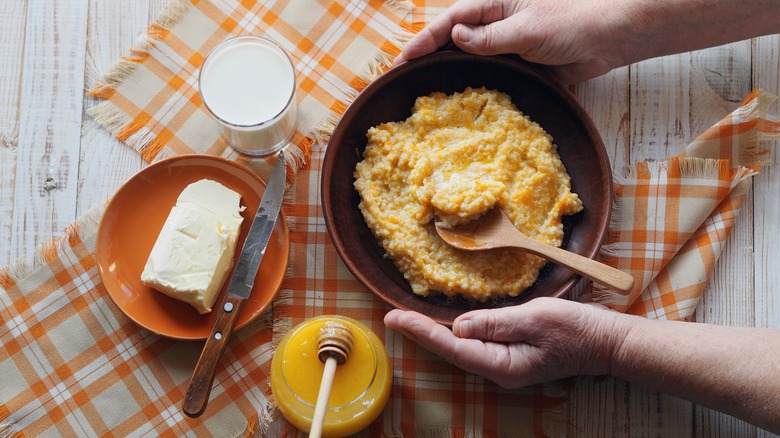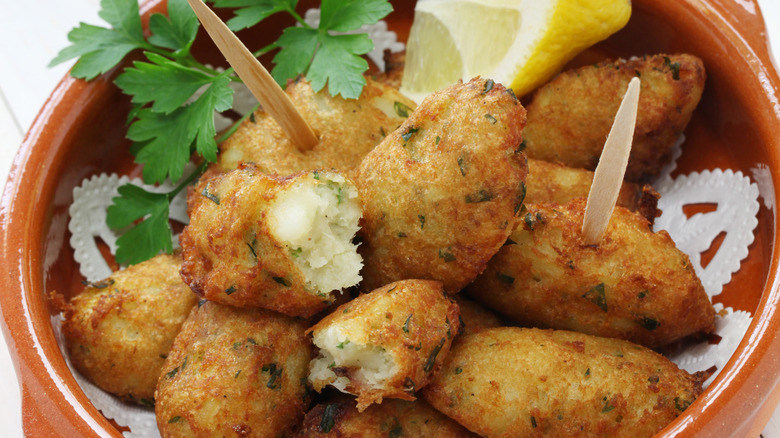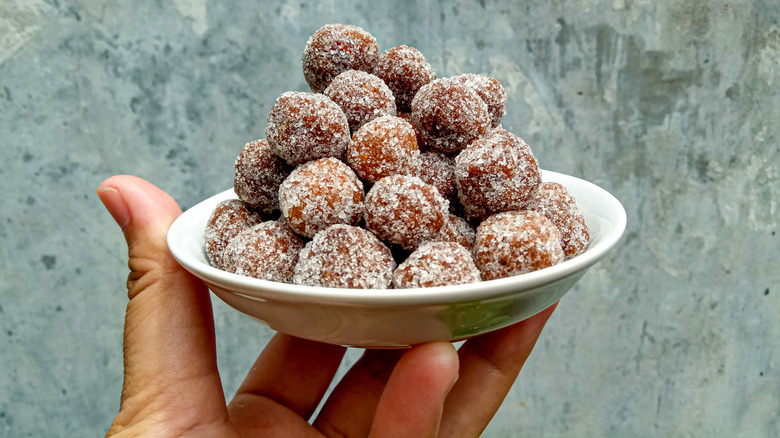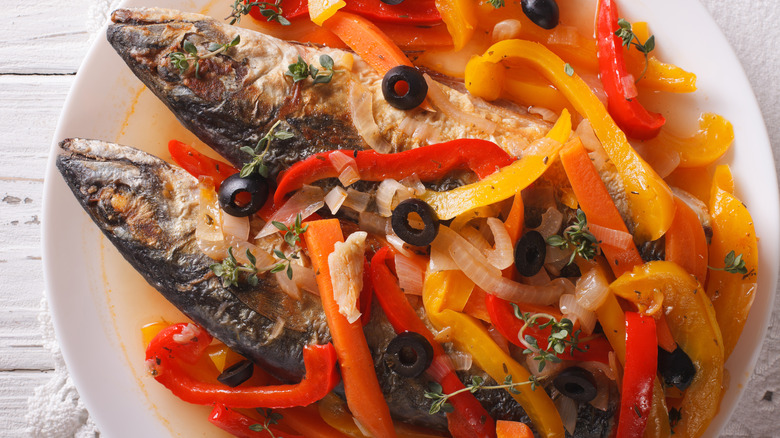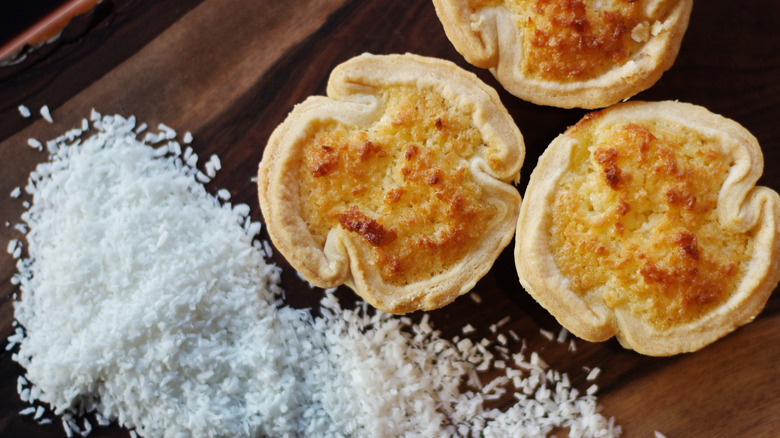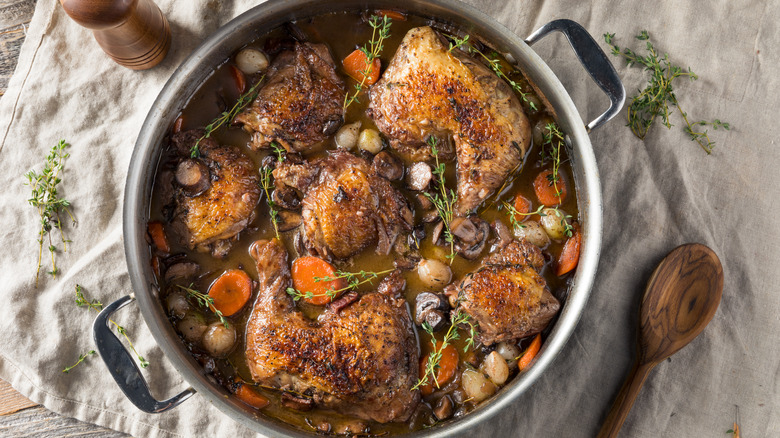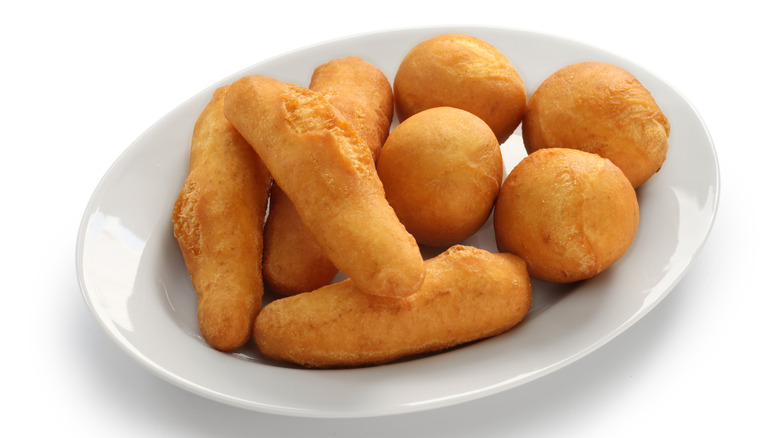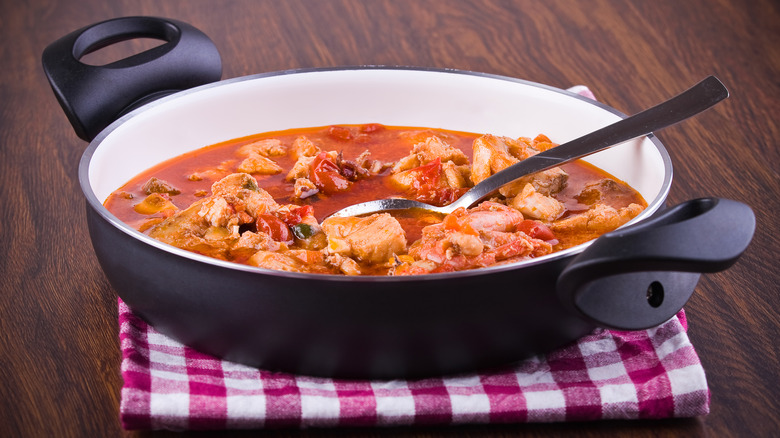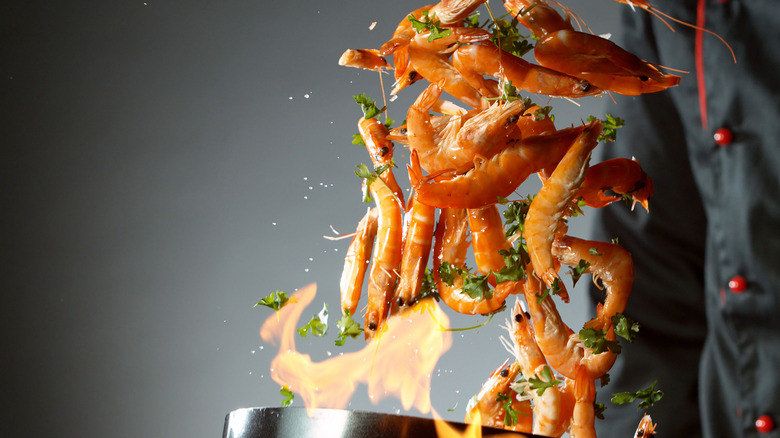25 Jamaican Dishes You Have To Try At Least Once
Correction 3/31/22: A previous version of this article stated that pimento wood cannot be shipped outside of Jamaica. Pimento wood can be shipped outside the country.
Deciding to go to out to dinner in the U.S. brings up some serious choices that need to be made. From Chinese to Italian to Mexican, almost every town has a multitude of cuisines available to enjoy. While Jamaican cuisine hasn't quite gotten the foothold that other cultures have nationwide, that doesn't mean there shouldn't be a Jamaican restaurant in every U.S. city for you to eat at.
Jamaican cuisine features a combination of food cultures, taking inspiration from the native Taíno and Arawak tribes, as well as incorporating bits and pieces of the cultures that settled there post 16th century. Global Foodways explains there's one crucial ingredient that makes many Jamaican dishes as amazing as they are: pimento wood. Used in smoking things like jerk chicken, the wood can't be purchased at just any grocery store, giving the dishes it's used in a distinct flavor you won't find anywhere else. African and Spanish influences are layered in to create a truly incredible, global cuisine — and these dishes should all be on everyone's "must-try" list.
1. The beef patty
The New York Times called the Jamaican beef patty a typical Jamaican food, and that's spot-on. Patties are everywhere; they're sold as street food and at convenience stores. And while they're the perfect on-the-go lunch, they're also ideal for wrapping up a night out after some drinks with friends or family.
If the idea of the patty — a delicious filling wrapped in a pastry crust — sounds familiar, there's a good reason for that. The idea has been around for a long time, and was brought to Jamaica by British immigrants familiar with the Cornish pasty, says Culture Trip. But these aren't Cornish pasties; they're sometimes filled with curried meat, are often spicy, and the flavors are 100% Caribbean. They've remained true to their roots and are a delicious, filling, and best of all, affordable hand-held meal sold across the country. In short, they're the perfect fast meal or anytime snack.
2. Ital stew
Ital isn't just a stew; it's a way of cooking and eating that aligns with traditional Rastafarian values of simplicity and freedom. Freedom? Yes: The New York Times says that what Ital cuisine is free from are things like artificial preservatives, colorings, and seasonings.
"Ital" is named for what it's supposed to give — vitality. It's right in line with other food movements that are trying to cut all things artificial out of diets. Anyone who's looking to add some tasty variety to their "Meatless Monday" menu can't find something better than this traditional Jamaican dish. Ital stew is downright delicious, and it's incredibly versatile. It's a hearty, flavorful dish overflowing with ingredients like pumpkin, cabbage, corn, and beans, and it is traditionally seasoned with allspice. Wheat dumplings are a common accompaniment, and they're often used to soak up the last of the delicious gravy. That's a good thing — you're not going to want to waste a drop.
3. Corn soup
Corn has a bit of a reputation as being an entry-level vegetable, but there's a reason it's been a staple in New World cuisines for a long, long time. There's a ton that can be done with it, and this Jamaican mainstay is perfect for cool afternoons and cooler evenings. Corn soup is exactly that — and so much more. Corn — or maize — is a key ingredient not only in Jamaican cuisine but in all Caribbean cooking. It's a common side dish, says the Stockholm Environment Institute, but it can also be the centerpiece of a hot, hearty meal.
Corn soup is, of course, spicy, but as One Green Planet notes, that shouldn't dissuade anyone from trying it. The heat level — which comes from either Scotch bonnet or habanero peppers — can be adjusted, and don't worry about the idea of the too-hot-to-handle Scotch bonnets. Add as much or as little as you'd like, and enjoy the rest of the traditional flavors: corn, coconut milk, bell peppers, onions, and plenty of seasonings.
4. Spinners and sinkers
So what the heck are spinners and sinkers? They're exactly what you'll need to make if you love dumplings. These traditional Jamaican dumplings aren't just easy to make — they're made with water, flour, and salt — but they're so hearty that they're the perfect addition to soups and stews.
As The Spruce Eats says, they're called spinners and sinkers because they don't float like other types of lighter dumplings. Instead, they spin on the surface of the water as they cook, and they'll typically end up submerged in whatever broth they're finished in. There's no right or wrong way to serve them, and these versatile dumplings can be added to other traditional dishes, or you can even opt to add them to some old family favorites. Since they'll sink into whatever liquid goodness you serve them in, that allows them to soak up all those wonderful flavors. They're a must-have in any soup!
5. Coco bread
Everyone has their favorite dishes that connect them with the places they've lived and grown up in. According to Food & Wine, it's coco bread that provides that link to countless Jamaicans who have left their home country for other areas.
What makes coco bread completely different from most other types of bread is, as the name suggests, the coconut milk that's used to make it. It's the sort of food that can transport anyone back to a time and a place. Thought to have been created at a time when many were struggling with scarcity, it continues to be a favorite for both those who never left home and those who have. While the best is the authentic stuff you'll pick up on any trip to Jamaica, it's also easy enough to make anywhere in the world, which means it's been a lifeline for those missing the place where they were born and raised.
6. Ackee and saltfish
If there's a national dish associated with Jamaica, it's ackee and saltfish. Ackee and saltfish is one of those dishes that anyone visiting just needs to try. Here's the thing: It should be tried in Jamaica because ackee is toxic when it's not ripe. Jamaican chefs have a lot of practice preparing this long-time favorite, and when it's sautéed with salted fish, tomatoes, onions, and chiles, it's phenomenal.
According to the BBC, ackee was taken to the Caribbean in the mid-17th century, and it thrived. That's a good thing; it provided a plentiful food source for people who didn't have much. Salted fish — usually cod — was also plentiful, so combining the two made for a delicious meal that didn't take much to make. For the island's enslaved peoples — who were the first to make it — the cheap and nutritious meal was a life-saver. Today, it remains a Jamaican favorite and a link to generations of ancestors.
7. Jamaican curry
Curry, says the Matador Network, simply refers to a blend of spices. While many might think of an Indian curry first, Jamaica has its own version of it — and it's not to be missed.
While other curries might have a base of tomatoes or coconut milk, Jamaican curry is typically made by marinating meat with a powder that is usually heavy on the turmeric and has a bright yellow color. Other popular spices include paprika, cumin, cardamom, and garlic, so anyone who's a fan of a smoky sort of heat will love Jamaican curry. If you visit, you'll see that goat is a common type of meat that's used. But if it's a dish you're looking to recreate at home, don't worry, any meat will do, and any will benefit from these smoky, spicy seasonings.
Like many dishes, this was influenced by the influx of outsiders that came with British rule. Today, embracing curry means embracing the past.
8. Fish tea
Fish tea? What? Granted, that sounds like a bit of an unusual thing, and the name of this one might be a little off-putting, but fish tea isn't actually tea made with fish, don't worry! It's a soup, and according to Taste Atlas, there's a little bit of folklore that comes along with this one.
Fish tea — which is made with small fish (like herring), vegetables, and sometimes even bananas — has long been thought to be something of an aphrodisiac. Rumor has it that this dish is the perfect thing to share during a meal to get someone in the mood for a little love. Honestly, although the science behind aphrodisiacs is still out, it's easy to see why the story developed around this. It's light — imagine a soup that has just as much broth as other ingredients — and here's the thing; it's commonly sold at stands along the beach. If that scenery and that light, tasty lunch doesn't get someone feeling the romantic vibes, then nothing will!
9. Roasted breadfruit
It's no secret that sides can be the most boring part of a meal. Chances are pretty good that every family has its usual sides, and they're often kind of an afterthought. But they don't have to be. Looking for something new? Want to skip the starchy potatoes and try something different? Pick up breadfruit, and whip up a deliciously authentic Jamaican side!
Taste Atlas says that this side is usually made from a whole breadfruit, which is roasted in whatever way is convenient. And that's good news for anyone wanting to try it at home — roasting one in the oven is a completely acceptable way to prepare it. After it's cooked, it can be served up just like it is or given a little extra crisp in the frying pan. It's simple, straightforward, and delicious, and anyone wanting to try this at home might find it a brilliant alternative. Drop the fries, and serve one alongside a burger. Yes, please!
10. Bammy
Salem State University says that while there are definitely variations between individual bammy recipes, the idea has stayed the same throughout Jamaica's long history.
It's essentially a crumpet-like flatbread made from the cassava root, but like so many Jamaican dishes, it's also much more than that. While today it's often prepared, then preserved, then stored before being soaked (preferably in coconut milk), then finally fried and served, it was originally much more labor-intensive and made from scratch.
These toasty-on-the-outside, soft-on-the-inside slices were originally made by the island's pre-Columbian native inhabitants. When the native people found themselves struggling to survive under the influx of European occupiers, the bammy went from a commonly-consumed dish to a lifeline for people oppressed and enslaved by European colonists. Countless people relied on it for nourishment and survival. Today, the bammy has become a popular snack. Sometimes sweetened, sometimes not, the bammy is so iconic that it's even been mentioned in countless works of fiction.
11. Oxtail
Go to any grocery store today, and it's likely there are going to be popular cuts of meat offered at the butcher's counter. There was a time, though, when slaughtering an animal meant using every part of it, and here's where oxtail comes in. Yes, it's exactly that, and while Insider says that it was once the tail of only an ox, modern dishes use the tail of any kind of cattle.
And don't knock it until you try it. Slow-braised oxtail goes back to a long tradition of one-pot meals because a good percentage of the tail is bone. Slow-cooking the tail means that the meat falls off the bone and into the broth, which is infused with all that flavor. That flavor all makes it onto the plate in some oft-overlooked delicacies, and here's the thing: It's a brilliant way to make use of the entire animal. And with no waste, it's a small step in making meat consumption just a little bit more responsible.
12. Black Cake
It might seem like black cake should be some kind of ultra-decadent chocolate cake, but that's not the case at all. According to Global Table Adventure, it's in the same tradition as the British plum puddings, which are incredibly dense cakes made with ingredients like raisins, currants, and molasses.
Oh — and a heck of a lot of booze.
There's so much booze, in fact, that making a truly authentic black cake can take months. Yes, months. Before the cake is baked, it's left to soak in alcohol — usually cherry brandy or rum — until it practically swells with deliciousness. Global Table Adventure stresses that this is in no way your grandmother's fruit cake, and anyone who's partaking in this sweet dessert might not want to plan on driving afterward. There's a good chance you're not going to want to anyway: This isn't a light, palate-cleansing dessert. It is a heavy, rich slice of divine goodness — the sort of cake someone will opt for if they're really, really serious about their cake.
13. Callaloo
Looking to make some sides that aren't just different but also healthier? Look no further than callaloo, a leafy green vegetable common throughout Caribbean cooking.
The Spruce Eats says that technically, callaloo is the leafy green part of a root vegetable, and what vegetable we're talking about can vary. That includes root veg like taro, amaranth, and dasheen, with dishes in Jamaica usually using amaranth for their callaloo. And while that kind of variety might seem pretty great for anyone who's thinking they might try this one at home, there's a catch: These fresh leaves aren't something that ship easily. Unless you're in the right place (the South) and have access to a farmers' market or grocer with a super-fresh produce section, you might be out of luck. Head to Jamaica, though, and you'll find bundles being sold for preparation in a way not dissimilar to what's done with spinach or for adding to soup or stew.
14. Jamaican jerk
The history of Jamaican jerk could fill textbooks, so let's just say this: It's such an important part of Jamaican history and culture that many describe it as tasting "like freedom." According to The Bermudian, true jerk is marinated and then grilled over a smokeless fire — and that's important. For the small populations of free people who first developed it, those smokeless fires helped keep European colonizers from finding and enslaving them.
While there are a variety of meats that can be left to marinate in jerk seasoning, it's only staying true to some of the traditional recipes that will make this fiery, spicy dish a homage to those who fought to stay free. And that's where the footnote to this comes in: Jerk is taken very seriously, and it's one of those dishes that when it's done, it needs to be done right. Otherwise, it's not jerk!
15. Mannish Water
Mannish Water is without a doubt an oddly-named dish, but according to Atlas Obscura, knowing what goes into it means that it's not as unique as it seems at first glance. Mannish Water is a goat soup, but as the name suggests, it's made with only the parts from male goats.
And we do mean all the parts. That includes everything from the reproductive organs to the entrails. It goes back to a time when all of the animal was used, and nothing was wasted. This flavorful soup is a great way to use up the bits that might otherwise be too difficult to eat. It's simmered for so long that some of the meat simply melts into the spicy broth that is full of veg and gets a one-of-a-kind heat from chiles. If that's not reason enough to try it, it's also said to be an aphrodisiac!
16. Cornmeal porridge
Porridge is a staple breakfast food in places across the world, and Jamaica is no different. In Jamaica, instead of a widely-eaten and more popular oatmeal, it's a cornmeal porridge that helps many people start their day — just like it has for generations.
According to Serious Eats, porridge isn't just made from cornmeal — although that's considered a favorite. It can — and is — made from any starchy vegetable that's readily available. That means that anyone visiting might find local favorites like green banana, green plantain, peanut, and even hominy porridge, which can be made with coconut or condensed milk. It's the latter that's usually drizzled on top, the finishing touch on a hot and hearty breakfast that will fill you up, keep you going, and not leave you feeling as uncomfortable as an equally popular American breakfast will. Breakfast, after all, shouldn't leave you feeling like you need a nap.
17. Stamp and go
The oddly-named stamp and go is sometimes a breakfast food, sometimes a snack, and sometimes sold by street vendors. According to Taste Atlas, there is no negotiating when it comes to the key ingredients of these fish fritters, and it's not stamp and go if it's not made with thyme, black pepper, and Scotch bonnet peppers. While that last one might make anyone think twice, don't worry: It's enough to give these fried fish fritters a spicy kick, but these are meant to be eaten on the run, so they're not going to be so overwhelmingly spicy that you'd expect to see them on a food challenge.
Otherwise, there is some variation to these traditional fritters, made with a mixture of salted cod shreds that are battered, fried, and drained before being sold to customers. The customers, incidentally, are those who gave the fritters their name: the story goes that after stamping their feet at the street vendor, they'd grab their food and go.
18. Tamarind balls
Tamarind trees are found throughout the Caribbean, believed to have been brought there by the Spanish and the Portuguese in the 1500s (via Jamaicans.com). Since then, these versatile trees and their fruits have been used for everything from furniture-making to bath oil. And while that might make them sound like they're the last ingredient you might expect to find as the main part of a bite-sized dessert, they are. Perhaps the best use of all is in the small, round dessert called tamarind balls.
They're just as delicious as they are simple, made with shelled tamarind, brown and white sugar, and — both optionally and ideally — red rum. There's nothing that says sweet treats need to be complicated, and these prove that sometimes simple is a good thing. Although some might opt to add a dash of heat in the form of peppers, most Jamaican traditionalists stick to the non-spicy, and that's absolutely delectable.
19. Jamaican fish escovitch
It's really no wonder that Jamaica has so many brilliant fish-based dishes. After all, location is everything, and, for generations, Jamaican cuisine has taken advantage of the bounty supplied by the surrounding waters. Fish escovitch is just one of those many dishes, and The Spruce Eats describes traditional fish escovitch as being kind of — but not exactly — like a Jamaican version of ceviche. There's a massive difference, though: Instead of serving the fish raw, it's first fried and then marinated. The result is a delicious, almost pickled fish served in the marinade, and that's important. There are usually bammies on the side, which is exactly what you want to soak up all that deliciousness.
Like many Jamaican dishes, this one goes back to the influence of the Spanish, who arrived in the 1500s. This was, after all, long before refrigeration, and the process of escabeche — which was adopted as escovitch — helped preserve the fish and keep it fresh.
20. Gizzada
The name "gizzada" might bring up images of gizzards, but there's nothing that's farther from what these sweet Jamaican treats are.
Imagine a tart-sized buttery pie crust filled with a mixture of brown sugar, coconut, ginger, and a mix of other spices. Sounds delicious, right? Currently wondering where these have been all your life? Us, too. Imagine them as a sweet treat, but not too sweet. Although A YouNique Journey says that while the ginger may or may not be included, authentic is better, right? It's the ginger that adds a unique tartness to these handheld desserts, and if there's anything that's better than ginger, it's the combination of ginger and coconut. Close your eyes, and you can almost imagine biting into one of these treats as the sun sets over the Jamaican landscape.
The origin of the dish is debated, with some saying it was created in Jamaica and others believing it was brought to the Caribbean by 16th century Jews fleeing Portugal and persecution. Either way, it's remained a popular sweet treat for centuries.
21. Brown stew chicken
The idea of a brown chicken stew might seem pretty vague, and, according to Serious Eats, this traditional Caribbean dish varies from island to island. It's a traditional favorite that's been made by generations of countless families, but there is something that sets a Jamaican version of this hearty stew apart from every other kind of stew.
It all has to do with the chicken and the way it's prepared before it even makes it into the stew. After it's marinated in citrus, the chicken is usually seared with oil and an ingredient called browning. Browning is key, as it's a sauce that is made with caramelized sugar but is more smoky than sweet. After the chicken is seared to give it the distinct flavor of molasses and smoke, it is then put into a brown gravy made with Scotch bonnet peppers and left to braise. This isn't your ordinary stew!
22. Festival dumpling
There are a few universal truths, and one of those truths is that fried dough is amazing. Whether you spend the afternoon making it at home or pick some up from the carnival, its brilliance is in simplicity. Different areas have their own version of this widely popular street food, and Jamaica's are a little different than other fried dough dishes of the Caribbean, says Immaculate Bites. The traditional version you'll find being served at festivals and from street vendors in Jamaica is made with cornmeal instead of plain flour, and that makes for a sweeter treat.
Add in the crispy exterior, and there's no way to go wrong. They're commonly served alongside another of our must-try dishes — escovitch — and visitors can find these treats being served up at roadside and beachside stands throughout the country. Honestly? The only thing that's better than eating them is eating them on a beach in Jamaica.
23. Janga soup
Janga soup is another traditional dish that — done right — pretty much has to be experienced in Jamaica. That's because janga is the name of the small, freshwater crayfish that populates the island's rivers, and, as Jamaica-No-Problem says, the soup made with any other crustacean just isn't the same. Like Jamaican jerk, it's one of those dishes that just has to be prepared in the right way with the right ingredients, or it becomes something else entirely. And you want the real deal, which is a dish — that yes, usually includes a Scotch bonnet pepper — that's simmered for a long time. That's why using janga is essential; they hold up better to the prolonged heat than substitutes like shrimp.
The janga are cooked in a broth along with vegetables like pumpkin and sweet potatoes. Taste Atlas says that it's been long popular for another reason; some swear that it has aphrodisiac properties.
24. Roast conch
Key Largo Fisheries says that, perhaps surprisingly, conch is one of the world's most popular seafood delicacies — and yes, that's the creature that lives in those shells that you can hear the ocean in. It's commonly steamed or served in salads or ceviche, but head to Jamaica, and you're likely to see another conch dish on menus — roast conch. It's been likened to a slightly rubbery version of crab, but that also means the meat needs to be tenderized before it's cooked to make sure it's more succulent than chewy.
That's why Jamaican Dinners says that, like many dishes, this one takes a lot of planning — specifically because it needs to marinate for at least a few hours (though overnight is preferable). The conch meat is chopped into small pieces first, then roasted in foil and served with vegetables. If that sounds appetizing, then Jamaica's roast conch dish is a must-try.
25. Peppered shrimp
Love shrimp? Obsessed with spice? Serious Eats has good news, and it's the fact that Jamaica's ever-popular peppered shrimp can absolutely be made in your own kitchen, all without the atmosphere of the street markets of the Middle Quarters. That, they say, is where you're most likely to find giant pots churning out the bright red shrimp, just a stone's throw from where they were pulled from the Black River.
Shrimp are boiled with Scotch bonnet peppers and a handful of other spices and seasonings. While they occasionally have food coloring added to them, there's a practical reason for that artificially-achieved, bright red color: It's a warning that they're not for the faint of heart. While it's possible to adjust the heat in many Jamaican dishes, peppered shrimp are incredibly hot. They're also the product of hundreds of years of catching shrimp and cooking street food. Flavorful heat makes this — like so many other Jamaican dishes — a must-try for any foodie.
